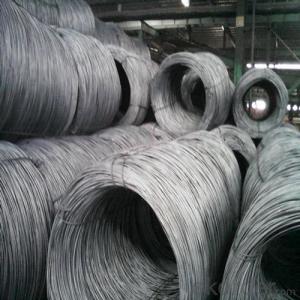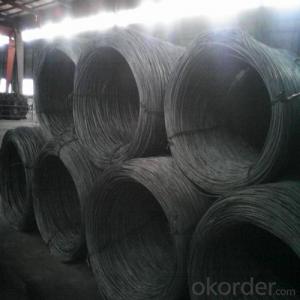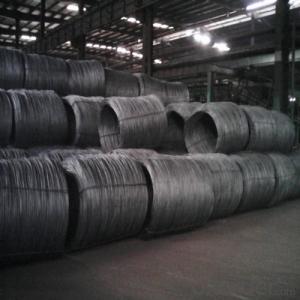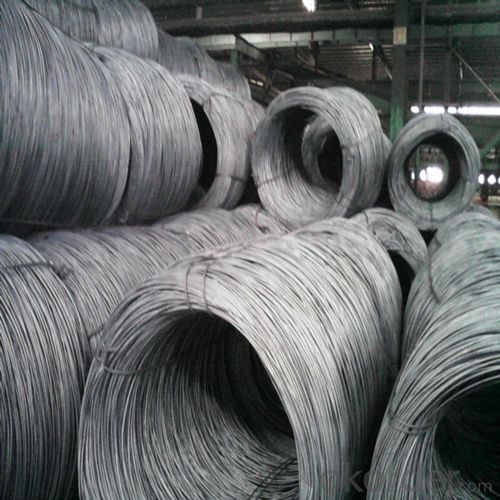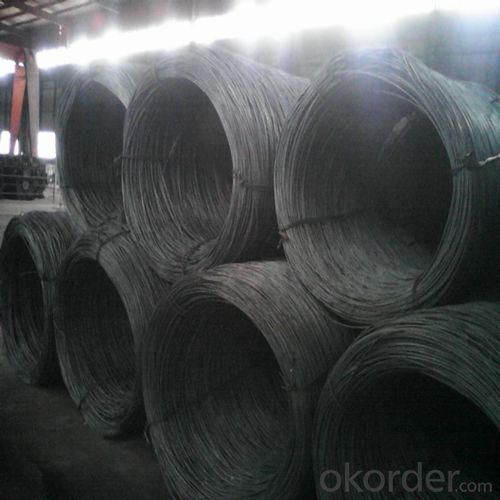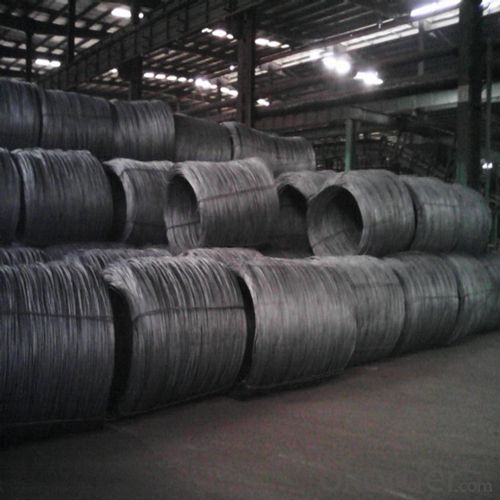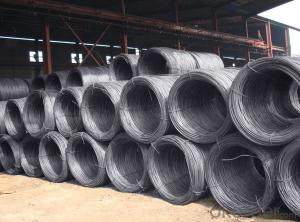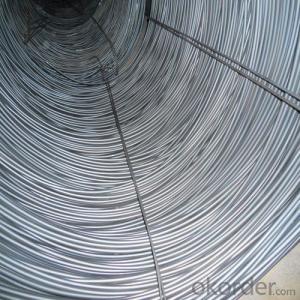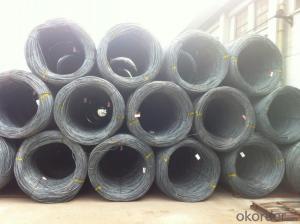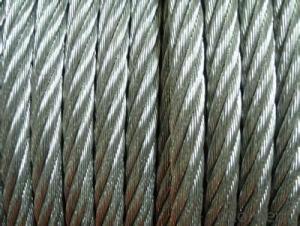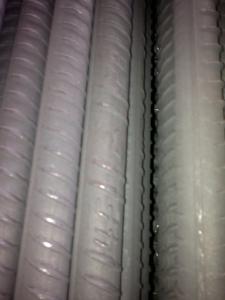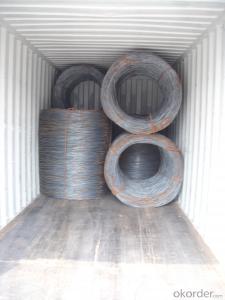Hot Rolled Wire Rod SAE1008 SAE1006 SAE1018 Made In China
- Loading Port:
- Tianjin
- Payment Terms:
- TT OR LC
- Min Order Qty:
- 500 m.t.
- Supply Capability:
- 30000 m.t./month
OKorder Service Pledge
OKorder Financial Service
You Might Also Like
Product Description:
Specifications of Hot Rolled Wire Rod:
Steel Grade: Q195/235, SAE1006-1018B Standard: ASTM, GB
Diameter: 5.5mm, 6.5mm, 7mm,8mm,9mm,10mm,12mm,14mm
Type: in coil, coil weight around 2MT Alloy or Not: Alloy
Technique: Hot Rolled Place of Origin: China Mainland
Surface: round, no twisted, light and smooth Brand Name: HSKY
Chemical Composition: (Please kindly find our chemistry of our material based on Q195、Q235A and Q235B as below for your information)
| Trademark | Rank | Chemical composition (quality score) % | ||||
| C | Si | Mn | S | P | ||
| ≤ | ≤ | ≤ | ||||
| Q195 | 0.06-0.12 | 0.30 | 0.25 | 0.050 | 0.045 | |
| Q235 | A | 0.14-0.22 | 0.30 | 0.30-0.65 | 0.050 | 0.045 |
| Q235 | B | 0.12-0.20 | 0.30 | 0.30-0.70 | 0.045 | 0.045 |
Chemical Composition:(Please kindly find our chemistry of our material based on SAE1006B and SAE1008B as below for your information)
Grade | Chemical Composition (%) | |||||
C | Mn | S | P | Si | B | |
SAE1006B | 0.03~O.07 | 0.32max | 0.045max | 0.040max | 0.30max | 0.0008min |
Mechanical properties | ||||||
Yield strength(N/mm2) | Tensile strength(N/mm2) | Elongation (%) | ||||
250-280 | 350-380 | ≥32 | ||||
Grade | Chemical Composition (%) | |||||
C | Mn | S | P | Si | B | |
SAE1008B | 0.10max | 0.3~0.50 | 0.050max | 0.040 max | 0.15max | 0.0008 min |
Mechanical properties | ||||||
Yield strength(N/mm2) | Tensile strength(N/mm2) | Elongation (%) | ||||
≥195 | 315-430 | ≥30 | ||||
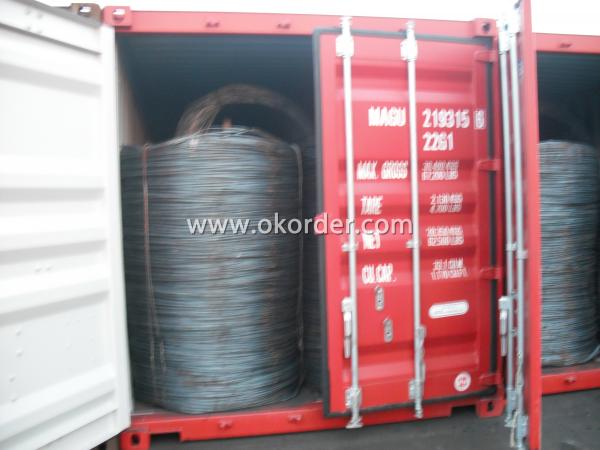
Wire Rod in Bulk Vessel
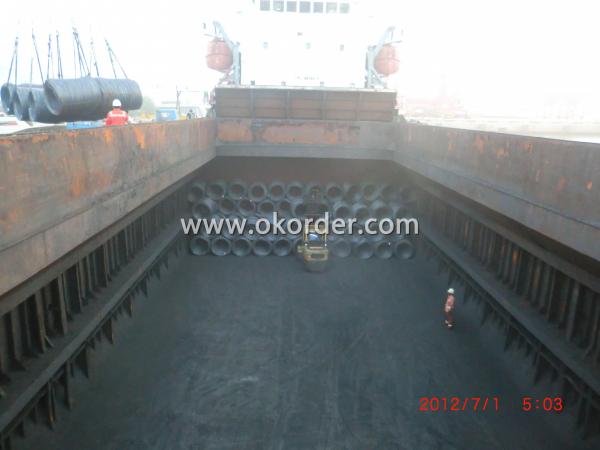
Note:
1. Our products are produced according to national standard (GB), if not, supply according to national standards (GB) or agreement as customer required.
2. Other Grade and Standard carbon steel wire rod we can supply:
Grade: H08A, 30MnSi, 62B-82B
Standard: AISI, BS, JIS, DIN
The Minimum Order Quantity of these products is high, and need to be confirmed.
3. We can not only supply carbon steel wire rod; if you need anything about building materials, please contact us.
4. Please send us your detail specifications when inquire. We will reply to you as soon as possible. We sincerely hope we can establish a long stable business relationship.
- Q: How is steel wire rod used in the manufacturing of musical instruments?
- Steel wire rod is commonly used in the manufacturing of musical instruments as it serves a variety of purposes. It is primarily utilized for producing strings, especially in instruments like guitars, pianos, and violins. The wire rod is drawn into thin, high-tensile steel wires, which are then wound and stretched to create the instrument's strings. These strings offer durability, flexibility, and the ability to produce clear and resonant tones. Additionally, steel wire rod may also be used in other components of musical instruments, such as springs, braces, or reinforcement elements, due to its strength and versatility.
- Q: What are the different types of wire rods for reinforcement made from steel wire rod?
- There are several different types of wire rods for reinforcement made from steel wire rod, including plain wire rods, deformed wire rods, and cold-drawn wire rods. Plain wire rods are smooth and have no surface deformations, while deformed wire rods have ridges or bumps along their surface to provide better grip and adhesion with concrete. Cold-drawn wire rods are manufactured through a process of drawing the wire through a series of dies, resulting in a smoother and more uniform product with enhanced strength and flexibility.
- Q: What are the common applications of pre-stressed and oil tempered steel wire rod?
- Pre-stressed steel wire rod is commonly used in construction and engineering applications, such as for pre-tensioning or post-tensioning of concrete structures, bridges, and high-rise buildings. It helps to improve the load-bearing capacity, durability, and overall structural integrity of these projects. On the other hand, oil tempered steel wire rod is frequently utilized in the manufacturing of springs, suspension systems, and other high-stress applications. Its unique properties, obtained through the tempering process, provide excellent resistance to fatigue and ensure reliable performance in demanding industries such as automotive, aerospace, and machinery.
- Q: How is steel wire rod used in the manufacturing of wire ties for construction sites?
- Steel wire rod is an essential component in the manufacturing of wire ties for construction sites. These wire ties are widely used in the construction industry for various purposes, such as securing rebar, reinforcing concrete structures, and fastening construction materials together. The steel wire rod serves as the raw material for producing wire ties. It undergoes a series of processes to transform it into the final product. First, the wire rod is cleaned and coated to enhance its corrosion resistance. This coating, often made of zinc, provides an added layer of protection against rust and ensures the wire tie's longevity in harsh construction environments. Next, the coated steel wire rod is fed into a wire drawing machine where it is pulled through a die to reduce its diameter to the desired size. This process is repeated several times to achieve the required wire thickness and strength. Once the wire is drawn to the desired gauge, it is then cut into appropriate lengths to produce individual wire ties. These lengths can vary depending on the specific application and requirements of the construction project. The wire is then bent, twisted, or formed into the shape of a tie using specialized machinery. Wire ties made from steel wire rod offer exceptional strength, durability, and flexibility. They can be easily bent or twisted to fit around various construction materials, ensuring a secure and tight connection. Moreover, the high tensile strength of steel wire rod ensures that the wire ties can withstand considerable stress and load without breaking or deforming. The wire ties manufactured from steel wire rod are commonly used in construction sites to secure and fasten rebar during concrete pouring. They are also used to reinforce concrete structures, such as walls, columns, and beams. Additionally, wire ties are employed to bundle or tie together construction materials, including pipes, cables, and electrical wires, ensuring proper organization and preventing potential hazards. In summary, steel wire rod plays a crucial role in the manufacturing of wire ties for construction sites. These wire ties provide essential support and reinforcement in various construction applications, offering durability, flexibility, and strength to ensure the safety and stability of construction projects.
- Q: How is steel wire rod used in the manufacturing of wire for automotive seat belts?
- Steel wire rod plays a crucial role in manufacturing wire for automotive seat belts, as it possesses exceptional strength and durability. Through a series of processes, the wire rod undergoes a transformation into the final wire used in seat belts. To begin, careful selection of the steel wire rod is conducted based on its specific properties, such as tensile strength and flexibility. Typically made from high-carbon steel, the rod is designed to endure the intense forces experienced during accidents. Subsequently, the selected steel wire rod is subjected to a process known as cold drawing. This process involves reducing the rod's diameter by pulling it through a series of dies, resulting in a thinner and more uniform wire. Cold drawing enhances the wire's strength and improves its surface finish. After cold drawing, the wire is commonly coated with a layer of zinc via galvanization. This coating acts as a protective barrier against corrosion, ensuring the wire remains resilient and reliable over time, even in harsh environments. The coated wire is then further processed to meet the specific requirements of automotive seat belts. Typically, it is wound onto spools or bobbins, ready to be fed into seat belt manufacturing machines. During the seat belt assembly process, the wire is cut to the desired length and threaded through the seat belt webbing. This wire provides the necessary strength and support to the seat belt, effectively restraining passengers during sudden stops or accidents. Overall, the utilization of steel wire rod in the manufacturing of wire for automotive seat belts plays a critical role in ensuring the safety and reliability of these vital safety devices. The steel wire rod's exceptional strength, durability, and resistance to corrosion make it an ideal material for seat belt production, providing peace of mind to manufacturers and consumers alike.
- Q: What are the applications of steel wire rods?
- Due to their strength, flexibility, and durability, steel wire rods find wide-ranging applications across various industries. Examples of their common uses include: 1. Construction: The construction industry heavily relies on steel wire rods to reinforce concrete structures. They are employed to create steel mesh, stirrups, and rebar, significantly enhancing the strength and stability of buildings, bridges, and other infrastructure. 2. Automotive sector: The automotive industry considers steel wire rods indispensable. They are employed to manufacture springs, suspension systems, tire reinforcement, and seat frames, providing the necessary strength and resilience for various automotive components. 3. Manufacturing: Steel wire rods are utilized in the manufacturing of a diverse range of products such as nails, screws, bolts, and wire mesh. These products serve applications in the construction industry, furniture manufacturing, and general fabrication processes. 4. Electrical industry: The electrical industry employs steel wire rods in cable and conductor production. They form the core of electrical cables, ensuring efficient electricity transmission over long distances. 5. Agricultural sector: Steel wire rods are used in the agricultural sector for fencing and animal enclosures. They provide a strong and durable barrier, ensuring the security and safety of livestock and crops. 6. Packaging industry: The packaging industry utilizes steel wire rods to produce wire-based packaging materials like wire baskets, racks, and crates. These products offer a sturdy and reliable solution for transporting and storing various goods. 7. Wire products: Steel wire rods are also transformed into a wide array of wire products, including wire ropes, springs, piano wires, and welding electrodes. These products cater to diverse industries such as mining, marine, manufacturing, and construction. In conclusion, steel wire rods have vast and diverse applications, spanning across construction, automotive, manufacturing, and electrical industries. Their strength, flexibility, and durability make them indispensable, playing a crucial role in enhancing the performance and reliability of various products and structures.
- Q: How is steel wire rod used in the manufacturing of wire rope pulleys?
- Steel wire rod is used in the manufacturing of wire rope pulleys as the primary material for the pulley's core construction. The steel wire rod is carefully formed and shaped to create the framework of the pulley, providing strength, durability, and flexibility required for its functioning. The wire rod's high tensile strength and resistance to wear and tear make it ideal for handling heavy loads and enduring rigorous usage in various applications that require wire rope pulleys.
- Q: What are the different storage methods for steel wire rod?
- The storage of steel wire rod varies depending on factors such as quantity, size, and condition. There are multiple methods available. One option is to stack the wire rod neatly and in an organized manner. This involves creating rows of wire rod coils on a stable surface like a concrete floor or a specially designed storage rack. It is crucial to stack the coils in a way that prevents rolling or collapsing for safety and easy access. Another method is to use wire rod racks or shelves. These racks are specifically designed to securely hold wire rod coils and prevent them from rolling or shifting. They often have dividers or compartments to keep each coil separate and well-organized. Vertical racks or stands can also be used, particularly when dealing with longer wire rod lengths. This method saves floor space by placing the rod vertically and securing it in place. For outdoor storage, designated areas with storage containers or shipping containers can be used. This provides protection from the elements and ensures the rod remains in good condition. Regardless of the chosen storage method, it is essential to protect the wire rod from moisture, dust, and other contaminants. This can be achieved by using plastic or metal covers or storing the rod in a climate-controlled environment. It's important to note that the specific storage method may vary depending on industry standards, regulations, and the specific requirements of the wire rod product. Consulting with industry experts or manufacturers is always recommended to determine the most suitable storage method for steel wire rod.
- Q: What are the main challenges in steel wire rod production?
- Manufacturers typically encounter several primary challenges in the production of steel wire rods. One of these challenges involves the need to maintain consistent quality and uniformity in the wire rod products. Given that these products are utilized in various sectors like construction, automotive, and manufacturing industries, it becomes crucial to adhere to strict quality control measures that align with the specific requirements and standards of each sector. Another significant challenge lies in optimizing the production process to achieve high productivity and efficiency. The production of steel wire rods encompasses multiple stages, including melting, casting, rolling, and finishing. Each stage necessitates appropriate equipment, skilled operators, and precise control to minimize downtime, decrease waste, and maximize output. Manufacturers must continuously analyze and refine their production processes to attain optimal efficiency. Moreover, the global steel industry confronts environmental challenges, such as the reduction of energy consumption, minimization of carbon emissions, and implementation of sustainable practices. The production of steel wire rods consumes substantial energy, particularly during the melting and rolling processes. Manufacturers are constantly exploring innovative technologies and methods to enhance energy efficiency, recycle waste materials, and diminish the environmental impact of their operations. Supply chain management also poses a critical challenge in steel wire rod production. Manufacturers must ensure a steady supply of raw materials, including iron ore and scrap metal, while establishing strong relationships with suppliers. Additionally, they must efficiently manage logistics to ensure prompt and reliable delivery of finished products to customers. Lastly, the steel wire rod market is fiercely competitive, with numerous domestic and international players. Manufacturers must consistently innovate and adapt to market trends, customer demands, and changing regulations to remain competitive. They must invest in research and development, product diversification, and marketing strategies to differentiate themselves and maintain a robust market position. In summary, the primary challenges in steel wire rod production revolve around quality control, production efficiency, environmental sustainability, supply chain management, and market competitiveness. Overcoming these challenges necessitates continual improvement, technological advancements, and strategic decision-making to ensure success in this demanding industry.
- Q: What are the different sizes available for steel wire rod?
- The sizes available for steel wire rod can vary depending on the specific requirements and applications. Common sizes range from 5.5mm to 25mm in diameter, with variations in length and weight. However, it's important to note that steel wire rod can be customized to meet specific size and dimension requirements as per the needs of the customer.
Send your message to us
Hot Rolled Wire Rod SAE1008 SAE1006 SAE1018 Made In China
- Loading Port:
- Tianjin
- Payment Terms:
- TT OR LC
- Min Order Qty:
- 500 m.t.
- Supply Capability:
- 30000 m.t./month
OKorder Service Pledge
OKorder Financial Service
Similar products
Hot products
Hot Searches
Related keywords

